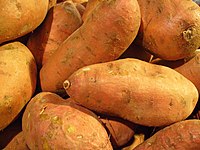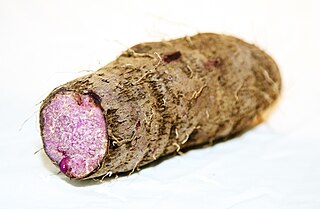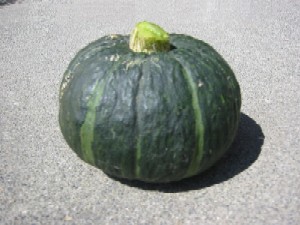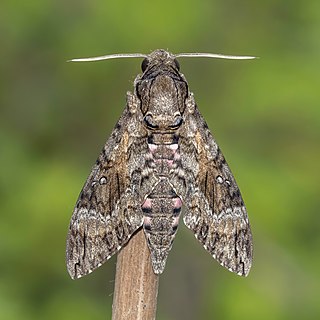| Name | Plant breeder | Parentage | Root skin (epidermis) colour | Root flesh (medulla) colour | Notes | Origin |
|---|
| Acadian | Louisiana State University [4] | L21 × L131 [4] | copper | orange | Does not appear | US |
|---|
| Allgold / Okla. 240 | Oklahoma State University–Stillwater [4] | Creole × Triumph (Parent 10) [4] | tan [1] | orange | Does not appear | US |
|---|
| Americana | ? | ? | ? | ? | Does not appear | ? |
|---|
| Apache | USDA (United States Department of Agriculture) [4] | (Yellow Yam 149 × Nancy Hall 42–1) × (Pelican Processor Triumph) [4] | orange | ? | Does not appear | US |
|---|
| Australian Canner | Department of Agriculture (Australia) [4] | ? | ? | ? | Adaptation trials/naming by USDA et al. [4] | Australia |
|---|
| Ayamurasaki | ? | indigenous | sangria | plum | Also called beniimo | Okinawa |
|---|
| Baker / V 2158 | Norfolk, Virginia [4] | Virginian × numbered seedling [4] | ? | ? | Does not appear | US |
|---|
| Beauregard | Baton Rouge, Louisiana [4] | open-pollinated seedling of L78-21 [4] | rose [5] | orange [5] | First cultivated in 1987 [5] | US |
|---|
| Bonara | ? | ? | ? | ? | Does not appear | ? |
|---|
| Campeon | ? | ? | light red [6] | white [6] | Commonly called boniato [6] (a word for sweet potato in Cuban Spanish) | ? |
|---|
| Canbake / G-52-15-1 | Georgia Agricultural Experiment Station (AES) [4] | ? | ? | ? | Does not appear | US |
|---|
| Caro-Gold | Clemson College [4] | C317 × Goldrush [4] | bright purple | orange | Does not appear | US |
|---|
| Carolina Bunch | US Vegetable Laboratory (USDA Agricultural Research Service); South Carolina AES [4] | open pollinated seedling of Excel [4] | light copper | deep orange | Does not appear | US |
|---|
| Carolina Nugget | North Carolina State University [4] | HM1-36 × Lakan [4] | rosy | medium orange | First cultivated in 1954 [4] | US |
|---|
| Carolina Ruby | North Carolina Agricultural Research Service (NCARS) [4] | open pollinated seedling of Beauregard [4] | dark red to purple-red [5] | dark orange [5] | First cultivated in 1988 [5] | US |
|---|
| Caromex | North Carolina State University [4] | NC228 × NC234 [4] | dark copper | deep orange | First cultivated in 1971 [4] | US |
|---|
| Carver | Tuskegee Institute [4] | Centennial × Jewel [4] | deep rose | deep orange | Does not appear | US |
|---|
| Centennial / L-3-77 | Louisiana AES (Baton Rouge, Louisiana) [4] | Unit IPR × Pelican Processor [4] | orange [7] | orange [7] | Does not appear | US |
|---|
| Chipper | ? | ? | ? | ? | Does not appear | ? |
|---|
| Covington NC98-608 | North Carolina State University [4] | ? | rose [5] | orange [5] | Smooth skin [5] | US |
|---|
| Cliett Bunch Porto Rico / Georgia Bunch Porto Rico | University of Georgia Coastal Plain Experiment Station (Tifton, Georgia) [4] | mutation from Vining Porto Rico [4] | ? | ? | Similar to Vining Porto Rico [4] | US |
|---|
| Coastal Red | University of Georgia Coastal Plain Experiment Station (Tifton, Georgia) [4] | open-pollinated seedling from GA-76 [4] | red | medium orange | First cultivated in 1978 [4] | US |
|---|
| Coppergold | L. A. Sharum (Fort Smith, Arkansas) [4] | selected mutation in Allgold [4] | russet copper | ? | Does not appear | US |
|---|
| Cordner | Texas AES and Oklahoma State University [4] | copper [5] | medium orange [5] | ? | First cultivated in 1983 [5] | US |
|---|
| Creole | ? | ? | ? | ? | Does not appear | ? |
|---|
| Darby | Louisiana AES (Baton Rouge, Louisiana) [4] | open pollinated seedling of L 83-523 [4] | dark rose | orange | Purple stems [4] | US |
|---|
| Don Juan | Puerto Rico AES (Río Piedras, Puerto Rico) [4] | selected from native stock [4] | ? | ? | Does not appear | Puerto Rico |
|---|
| Earlyport | Louisiana AES (Baton Rouge, Louisiana) [4] | (Mameyita × seedling L-4-6) × (seedling L-5 × Triumph) [4] | copper | orange | Similar to Porto Rico [4] | US |
|---|
| Earlysweet / T-3 | University of Georgia Coastal Plain Experiment Station (Tifton, Georgia) [4] | Porto Rico × unnamed breeding lines [4] | light-skinned | deep orange | Does not appear | US |
|---|
| Eureka | Louisiana State University AES; University of California AES [4] | L9-163 × LO-132 [4] | copper | orange | Does not appear | US |
|---|
| Evangeline | Louisiana [8] | ? | rose | orange [8] | Does not appear | US |
|---|
| Excel | USDA and the South Carolina AES [4] | open-pollinated seedling of Regal polycrossed in 1981 to 29 other parental selections [4] | light copper | orange | Skin color is slightly lighter than that of Jewel [4] | US |
|---|
| GA90-16 | Georgia AES; US Vegetable Laboratory (USDA ARS) [4] | ? | ? | white | Low sugar, low maltose [4] | US |
|---|
| Garnet | ? | ? | pale copper | brilliant orange | Commonly called "yams" in the United States to distinguish them from O'Henry sweet potatoes [4] | US |
|---|
| Georgia Jet | ? | ? | purplish red | deep orange | Does not appear | US |
|---|
| Georgia Red / T-6 | University of Georgia Coastal Plain Experiment Station (Tifton, Georgia) [4] | Porto Rican crosses [4] | coppery-red skin | ? | Similar to Porto Rico [4] | US |
|---|
| Gold Rush | Louisiana AES (Baton Rouge, Louisiana) [4] | (Mameyita × Seedling L4-6) × (Seedling L-5 × Triumph) [4] | light copper | deep orange | Purple stems [4] | US |
|---|
| Golden Belle | Bryce Woods (Rogers, Arkansas) [4] | Nancy Gold mutation [4] | ? | golden | Flesh color differs from Nancy Hall. | US |
|---|
| Goldmar | Maryland AES (College Park, Maryland) [4] | Redmar mutation [4] | golden | ? | Cultivated in 1973. Similar to Redmar, but different skin color. [4] | US |
|---|
| Grand Asia | ? | ? | pink | white | Boniato-type similar to 'Japanese' [9] | ? |
|---|
| Hannah Sweet | ? | ? | ? | ? | Does not appear | ? |
|---|
| Hayman White | ? | ? | tan [10] | cream [10] | An heirloom variety of the Eastern United States [11] [12] | US |
|---|
| Heartogold | Louisiana State University [4] | Mameyita × Yellow Yam [4] | flesh-colored | deep orange | Does not appear | US |
|---|
| Hernandez | Louisiana State University AES [4] | seedling of L70-323 [4] | burnt orange [5] | deep orange [5] | First cultivated in 1992 [5] | US |
|---|
| HiDry | Clemson University; USDA [4] | fourth-generation, open-pollinated selection from MK-14 [4] | white | cream | Cultivated for industrial use [4] | US |
|---|
| Hoolehua Gold | ? | ? | pale red | orange | Does not appear | ? |
|---|
| Hoolehua Red | ? | ? | red | off-white | Does not appear | ? |
|---|
| Hopi / HM-122 | USDA Horticultural Field Station (Meridian, Mississippi) [4] | ? | ? | ? | Does not appear | US |
|---|
| Houhere | Māori traditional | pre-European "kūmara" type [13] | pink | yellow | Rectangular tubers | New Zealand |
|---|
| Hutihuti | Māori traditional | pre-European "kūmara" type [14] | cream | cream | Long, thin, up to 20 roots per plant [13] | New Zealand |
|---|
| Iliua | ? | ? | ? | ? | Does not appear | ? |
|---|
| Japanese / Oriental | ? | ? | purplish red | pale | Boniato-type. [9] Comparatively lower moisture. [8] | ? |
|---|
| Jersey Orange / Orange Little Stern | Kansas State College; Rutgers University [4] | ? | orange-brown | deep orange | Size and shape are similar to that of Jersey Yellow [4] | US |
|---|
| Jersey Red | ? | ? | ? | ? | An heirloom variety [10] | US |
|---|
| Jersey Yellow | ? | ? | golden, buff, or tan | cream to bright yellow | An heirloom variety [10] | US |
|---|
| Jewel | North Carolina State University | ? | copper [5] | deep orange [5] | First cultivated in 1970. [5] Commonly called "yams" in the United States to distinguish them from O'Henry sweet potatoes. | US |
|---|
| Kandee / K1716 | Kansas State College [4] | La 1946 Cross 17 × 1 (yellow yam × Nancy Hall) [4] | reddish bronze | bright orange | Does not appear | US |
|---|
| Kona B | ? | ? | pale red to orange-red | light orange | Does not appear | ? |
|---|
| Kote Buki | ? | ? | purplish red | white | Mid-season | ? |
|---|
| Lakan / L-0-123 | Louisiana AES (Baton Rouge, Louisiana) [4] | (Unit IPR × Pelican. Processor) × (Mameyita × L-4-6) [4] | reddish-bronze to reddish-tan | bright orange | Does not appear | US |
|---|
| Mameyita | ? | ? | ? | ? | Does not appear | ? |
|---|
| Maryland Golden | ? | ? | ? | ? | Does not appear | US |
|---|
| Miguela | ? | ? | ? | ? | Does not appear | ? |
|---|
| Murasaki | ? | ? | hybiscus | pale | Low moisture [8] | ? |
|---|
| Murff Bush Porto Rico | E. L. Murff (Normangee, Texas) [4] | Porto Rico mutation [4] | copper [7] | orange [7] | First cultivated in 1949. Similar to Porto Rico. [4] | US |
|---|
| Nancy Gold | Kansas State College AES [4] | Nancy Hall mutation [4] | buff-colored | deep-orange | Skin color differs from Nancy Hall [4] | US |
|---|
| Nancy Hall | ? | ? | tan | yellow | Does not appear | ? |
|---|
| Nemagold / Okla. 46 | Oklahoma State University–Stillwater [4] | Yellow Jersey (Orlis strain) × Okla. 29 [4] | ? | ? | Does not appear | US |
|---|
| Northern Star | ? | ? | ? | ? | Cultivated in Australia | ? |
|---|
| Nugget / NC-171 | North Carolina AES (Raleigh, North Carolina) [4] | NC-124 × (NC-41 × B5965) [4] | ? | ? | Does not appear | US |
|---|
| O'Henry | Henry Wayne Bailey [(Vardaman, MS)] [15] | Beauregard mutation [15] | coppery tan | lemon cream | Variant of Beauregard [8] | US |
|---|
| Okla. 46 | Oklahoma State University–Stillwater [4] | Okla. 29 × Orlis [Okla. 29-Parent 10 (see Allgold) × L37 (see Red Gold)] [4] | golden russet | orange | Roots and vines are like yellow Jersey or Orlis; shouldered leaves | US |
|---|
| Oklamar / Okla. 52 | Oklahoma State University–Stillwater AES [4] | Oklahoma 5 × Australian Canner [4] | purple | salmon | Does not appear | US |
|---|
| Oklamex Red | Oklahoma and New Mexico AES | B 1564 × PI 153655 | dark red | salmon | Extremely sweet, moist root; yam-type | US |
|---|
| Onokeo | ? | ? | violet | ivory | Does not appear | ? |
|---|
| Onolena / HES number 14 | Vegetable Crops Department, University of Hawaii (Honolulu) [4] | Porto Rico × Nancy Hall [4] | tan | dark orange | Similar to Porto Rico [4] | US |
|---|
| Orange Sunset | Plant & Food Research | ? | purple | orange and purple | First cultivated in 2014 [16] | New Zealand |
|---|
| Orlis | Kansas State College [4] | mutation from Common Little Stem Jersey [4] | bronze | ? | Similar to Little Stem Jersey | US |
|---|
| Owairaka Red | Fay Gock and Joe Gock [17] | waina type [18] [16] | dark red | yellow | As of 2000, the preeminent cultivar of New Zealand (followed by Toka Toka Gold and Beauregard) [19] | New Zealand |
|---|
| Papota | USDA ARS; Tropical Agricultural Research Station [4] | International Institute of Tropical Agr. seedling [4] | white | beige | Turnip-shaped root [4] | US |
|---|
| Parapara | Māori traditional | ? | pink | ? | Medicinal variety, used to feed babies, the elderly, and the sick [20] | New Zealand |
|---|
| Pelican Processor / L-5 / L-4-5 | Louisiana AES (Baton Rouge, Louisiana) [4] | selfed seedling of Americana [4] | cream | light cream | Does not appear | US |
|---|
| Picadita | ? | ? | purple-red [6] | white [6] | Commonly called boniato [6] (a word for sweet potato in Cuban Spanish) | ? |
|---|
| Pope | North Carolina State University [4] | NC 288 × 304 [4] | light salmon | medium orange | Does not appear | US |
|---|
| Poporo | Māori traditional | ? | purple | purple | traditional sweet and dry variety [20] | New Zealand |
|---|
| Porto Rico 198 / Porto Rican / Puerto Rican | North Carolina [5] | ? | rose-pink [5] | orange mottled [5] | First cultivated in 1966 [5] | US |
|---|
| Purple Dawn | Plant & Food Research | ? | purple | purple | First cultivated in 2014 [16] | New Zealand |
|---|
| Purple Heart / Okinawa | Okinawa Island | ? | tan | grape | Also cultivated in Hawaii | Japan |
|---|
| Queen Mary / L-126 | Louisiana AES (Baton Rouge, Louisiana) [4] | Porto Rico × Nancy Hall [4] | ? | ? | Similar to Porto Rico [4] | US |
|---|
| Ranger | Louisiana State University [4] | Porto Rico × Nancy Hall [4] | flesh-colored | orange | Similar to Nancy Hall | US |
|---|
| Rapoza | ? | ? | ivory | purple | Does not appear | ? |
|---|
| Rekarawa | Māori traditional | ? | white | ? | chestnut flavour [20] | New Zealand |
|---|
| Rekamaroa | Māori traditional | pre-European "kūmara" type [13] [14] | white | ? | Does not appear | New Zealand |
|---|
| Red Diane | ? | ? | ? | ? | Does not appear | ? |
|---|
| Red Garnet | ? | ? | deep red to purple [15] | orange [15] | Does not appear | ? |
|---|
| Red Jewel | ? | ? | red | deep orange | Does not appear | ? |
|---|
| Red Nancy | Kansas State College [4] | mutation of Nancy Gold [4] | red | orange | Similar to Nancy Gold [4] | US |
|---|
| Redglow | University of Georgia AES; California AES [4] | open pollinated seedling of GA-109 [4] | light, purple-red | deep orange | Does not appear | US |
|---|
| Redgold / Okla. 26 | Oklahoma State University–Stillwater [4] | Okla. 2 × L37 (seedlings involving Creole, Nancy Hall and Porto Rico) [4] | red | orange | Does not appear | US |
|---|
| Redmar / Md 2416 | Maryland AES (College Park, Maryland) | [(K18400 × B6313) × Shoreland × (Virginian × K1846)] | red | ? | First cultivated in 1971. Similar to Nemagold [4] | US |
|---|
| Regal | USDA ARS; South Carolina AES (Clemson University); Texas Agricultural Station (Texas A&M University) [4] | seedling of W-99 polycrossed with 29 other parental selections [4] | dark purplish-red | orange to deep orange | Does not appear | US |
|---|
| Resisto | USDA; South Carolina AES; Texas AES [4] | seedling of W-56 [4] | reddish-copper | dark orange | Does not appear | US |
|---|
| Rojo Blanco | Tuskegee Institute [4] | Rose Centennial × White Triumph [4] | deep red | milk white | Does not appear | US |
|---|
| Romanawa | Māori traditional [20] | ? | gold | yellow/orange | Does not appear | New Zealand |
|---|
| Rose Centennial | ? | ? | ? | ? | Does not appear | ? |
|---|
| Ruddy | US Vegetable Laboratory (USDA ARS); South Carolina AES [4] | open pollinated seedling of W-119 [4] | red skin | orange | Does not appear | US |
|---|
| Scarlet | North Carolina Agricultural Research Service (NCARS) [4] | selected from meristem-tip culture derived clones of Jewel [4] | ? | orange | Does not appear | US |
|---|
| Shore Gold | Virginia Tech Experiment Station [4] | open pollinated seedling of L7-177 from the Louisiana breeding program [4] | light copper | bright orange | Does not appear | US |
|---|
| Southern Delite | USDA ARS; Clemson University [4] [15] | an open pollinated seedling of W-99 [4] | rose to dark copper | orange | Made publicly available in 1986. [15] Skin color varies with soil type [4] | US |
|---|
| Stokes Purple | Unknown (North Carolina) [21] | | purple gray | dark purple | Made publicly available in 2012. | US |
|---|
| Sumor | USDA ARS; United States Vegetable Laboratory; South Carolina AES (Clemson University); Edisto Research and Education Center [4] | open pollinated seedling of W-154 [4] | light tan | white to yellow | Comparatively high vitamin C [15] | US |
|---|
| Sunnyside | USDA (Beltsville, Maryland and Louisiana) [4] | (Yellow Yam × Nancy Hall) × (Pelican Processor × Triumph) [4] | ? | ? | Does not appear | US |
|---|
| Sweet Red | North Carolina State University [4] | open pollinated seedling of NC 258 [4] | deep copper-red | deep orange | Does not appear | US |
|---|
| Tango | USDA; Missouri AES (Columbia, Missouri); Sweet Potato Cooperative Group (Beltsville, Maryland) [4] | Nancy Hall × Porto Rico 1-10 [4] | ? | ? | Does not appear | US |
|---|
| Tanhoma | Oklahoma State University–Stillwater AES [4] | selection Australian Canner [4] | ? | ? | Does not appear | US |
|---|
| Taputini | Māori traditional | pre-European "kūmara" type [14] | cream | cream | Long, thin, up to 20 roots per plant [13] | New Zealand |
|---|
| Toka Toka Gold | ? | ? | gold | white | Became commercially available in 1972 [22] [16] | New Zealand |
|---|
| Topaz | Texas AES [4] | open pollinated seedling of W-26 [4] | bronze | medium orange | Does not appear | ? |
|---|
| Travis | Louisiana AES [4] | polycross with L3-217 as seed parent [4] | rose | deep orange | First cultivated in 1980 | US |
|---|
| UPLSP-1 | ? | ? | ? | ? | Cultivated in the Philippines [23] | ? |
|---|
| UPLSP-2 | ? | ? | ? | ? | Cultivated in the Philippines [23] | ? |
|---|
| U.P.R. number 3 | Puerto Rico AES (Río Piedras, Puerto Rico) [4] | selected from Mameya; open-pollinated [4] | ? | ? | Does not appear | Puerto Rico |
|---|
| U.P.R. number 7 | Puerto Rico AES (Río Piedras, Puerto Rico) [4] | L-240 [4] | ? | deep orange | Does not appear | Puerto Rico |
|---|
| Vardaman | ? | ? | golden [7] | light orange | Does not appear | US |
|---|
| Virginian / V-53 | Truck Experiment Station (near Norfolk, Virginia) [4] | Maryland Golden × B-219 [4] | purplish-red to copper-red | bright orange | Does not appear | US |
|---|
| VSP-5 | ? | ? | ? | ? | Cultivated in the Philippines [23] | ? |
|---|
| VSP-6 | ? | ? | ? | ? | Cultivated in the Philippines [23] | ? |
|---|
| Waimanalo Red | ? | ? | red | pearl | Does not appear | ? |
|---|
| Waina | ? | ? | ? | ? | Vining variety brought to New Zealand in the 1800s [18] | ? |
|---|
| White Delite | North Carolina State University [4] | cross between a University of Georgia breeding clone (GA41) and an unknown pollen parent [4] | purplish pink [5] [9] | white [5] | First cultivated in 1979 [5] | US |
|---|
| White Triumph | ? | ? | ? | ? | Does not appear | ? |
|---|
| Whitestar | USDA (Beltsville, Maryland) [4] | cultivar Laupahoehoe (Hawaii) [4] | white | pale | Does not appear | US |
|---|
| Yellow Yam | ? | ? | ? | ? | Does not appear | ? |
|---|















